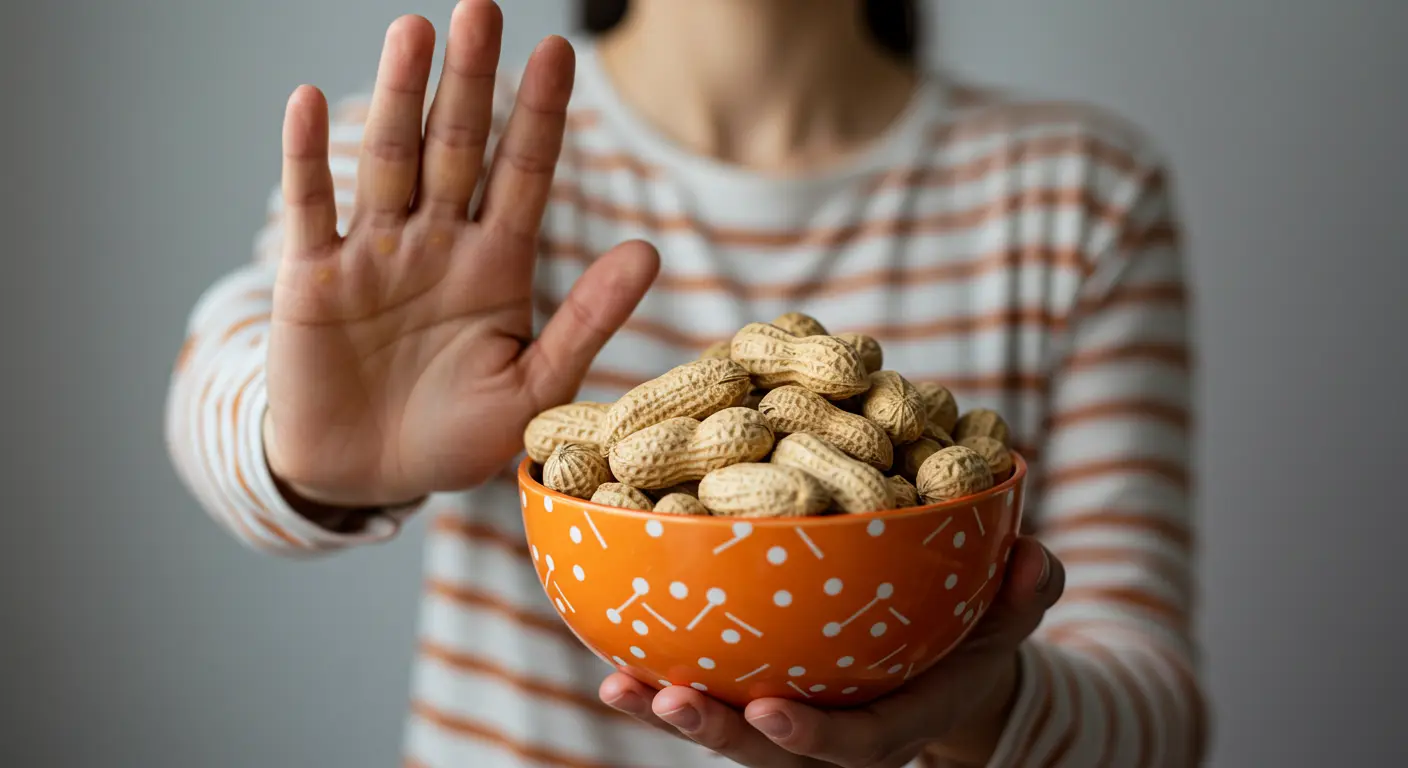
What Foods to Avoid with a Peanut Allergy?
Dealing with a peanut allergy means being extra cautious about what goes on your plate. Peanuts can hide in foods you wouldn’t expect, making awareness essential. From processed snacks to restaurant meals, dangers lurk where you least anticipate them. Knowing which foods to avoid can prevent unnecessary health risks and keep meals stress-free.
We understand how overwhelming this can be. Our team at Frontier Allergy & Asthma provides expert guidance to help you identify unsafe foods and manage your allergy with confidence.

Processed Foods That May Contain Peanuts
Baked Goods
Baked goods like cookies, cakes, and bread are prime examples. These treats, along with items like marzipan, often share production facilities with peanut-containing products, making cross-contamination a concern.
Pre-packaged snacks
Pre-packaged snacks such as trail mix, pretzels, and chips frequently contain peanut butter or peanut flour as an ingredient, while sauces like chili, salsa, or gravy might hide peanuts in their rich flavors.
Processed foods
Even processed foods such as instant noodles and salad dressings can surprise you with peanut traces.
Breakfast Cereals
Breakfast cereals aren’t always safe either—some brands sneak in peanut-based flavorings, like natural flavors or hydrolyzed vegetable protein, while others might be processed alongside tree nuts such as almonds, cashews, or walnuts, which can conceal peanut contamination.
Chocolate
Chocolate, especially milk chocolate and ice cream are other culprits that often harbor peanuts, as are confectionery treats like nougat and fudge.
Spices
Spices such as cumin or coriander and sauces like pesto or marinades can also be hidden sources, so checking food labels closely can prevent an accidental reaction.”
Unexpected Sources of Peanut Exposure
Sauces and salad dressings
Peanuts can show up in places beyond the usual suspects. Sauces and salad dressings are a major example. Peanut oil is common in some salad dressings, while Asian-inspired dishes might include peanut-based sauces.
Candies and chocolates
If you have a sweet tooth, candies and chocolates could be risky. Even if a candy doesn’t contain peanuts, it may have been processed in the same facility as peanut-filled treats.
Meat substitutes
Meat substitutes, especially vegetarian burgers and plant-based protein products, sometimes use peanut derivatives as a binder, making it crucial to read labels before consumption.
Cross-Contaminated Foods in Restaurants
Dining out with a peanut allergy comes with challenges. Fast food restaurants often use shared fryers, meaning peanut residue from one item can transfer to another. Even a small trace is enough to cause a reaction.
Certain cuisines pose a higher risk. Asian and African dishes frequently use peanuts as a core ingredient in everything from peanut-based curry sauces to ground peanut garnishes.
Shared kitchen equipment is another issue. A restaurant may prepare peanut-containing dishes on the same surfaces as other foods, making cross-contact unavoidable without strict precautions.
How to Identify Peanuts in Food Labels
Reading a label isn’t always as simple as spotting the word “peanut.” Food companies use various terminology, requiring extra vigilance. Knowing key terms and understanding labeling regulations ensures safer choices.
Common Terms That Indicate Peanuts
Peanuts hide under different names. Ingredients like hydrolyzed vegetable protein, groundnut, and arachis oil all indicate peanut derivatives. Peanut protein names such as peanut flour or peanut meal also frequently appear in ingredient lists.
Some products use alternatives that still contain peanut properties. For example, artificial nut flavoring sometimes includes peanut extracts. Recognizing these terms makes it easier to avoid hidden dangers when buying packaged foods.
Regulations on Allergen Labeling
Labeling rules differ between countries. In the U.S., the FDA requires companies to list peanuts explicitly if present in a product. Terms like “contains peanuts” provide clarity, but statements such as “may contain traces of peanuts” or “processed in a facility that also processes peanuts” indicate possible cross-contamination, even if peanuts aren’t a direct ingredient.
International guidelines may lack uniform standards. For example, European labels follow different formats, and some regions may not emphasize allergen risks as clearly. Checking labels carefully remains necessary, no matter where a product originates.
Strategies to Avoid Accidental Peanut Exposure
Managing a peanut allergy requires more than avoiding certain foods. Using smart shopping practices, preparing allergy-proof meals, and taking precautions while dining out are vital for staying safe.
Tips for Grocery Shopping and Meal Planning
Choosing reliable brands that prioritize peanut-free products eliminates much of the guesswork. Some companies specialize in allergy-friendly foods, making them safer options.
Reading ingredient labels is essential. Some brands change formulations, meaning a product that was once safe may later include peanut traces. Checking every time, even if it’s a familiar item, helps prevent reactions.
Preparing a Peanut-Free Kitchen
A peanut-free kitchen requires careful measures. Using separate utensils, cutting boards, and storage containers prevents cross-contact with peanut-containing foods.
Regularly cleaning surfaces, including countertops, stovetops, and cookware, reduces the risk of contamination. Dish sponges and towels should also be swapped out frequently to avoid accidental spread of allergens.
Eating Out and Traveling Safely
Communicating allergy concerns at restaurants is critical. Asking staff about food preparation and requesting modifications helps minimize risks. Some restaurants even offer dedicated allergy menus.
While travelling, carrying allergy-friendly snacks ensures there’s always a safe option available. Bringing a chef card explaining the allergy in different languages can also help when dining in unfamiliar locations.
Alternative Foods and Baking Substitutes for Peanuts
Replacing peanuts with safer options doesn’t mean sacrificing flavor. Plenty of alternatives exist for snacking, cooking, and baking.
Safe Nut and Seed Alternatives
Sunflower butter and soy spreads provide creamy, peanut-free alternatives perfect for sandwiches and recipes that call for peanut butter.
Seeds like pumpkin, flax, and chia work well as replacements when making energy bars or granola. They provide crunch and nutrition without posing a peanut allergy risk.
Peanut-Free Baking Options
Baking without peanuts is easy with the right substitutes. Almond or sunflower seed flours replace peanut flour effectively, while tahini or coconut butter can stand in for peanut butter in recipes.
Experimenting with peanut-free dessert recipes allows for creativity while ensuring safety. Ingredients like carob powder or toasted coconut help replicate flavors found in peanut-based treats.
Dealing with Social Situations and Peanut Allergy Safety
Social gatherings, school events, and celebrations require extra awareness to avoid allergens. Planning ahead and communicating clearly with those involved help prevent unexpected exposure.
Managing Peanut Allergy at School and Work
Educating teachers and coworkers about allergy risks can make daily interactions safer. Informing schools about allergy policies and keeping emergency medication accessible are important steps.
Packing safe lunches and snacks ensures meals remain peanut-free. Bringing labeled containers can help prevent accidental swaps in shared spaces.
Handling Social Gatherings and Celebrations
Talking to hosts before attending a gathering allows for menu adjustments if needed. Some may be willing to prepare peanut-free dishes.
Bringing personal food options ensures a safe meal while avoiding the risk of cross-contact. Keeping an EpiPen nearby is also a good precaution when attending events where food is shared.
Stay Safe and Confident: Making Smart Food Choices
It’s easy to feel overwhelmed when figuring out which foods are safe to eat. One small mistake can lead to a reaction that disrupts the entire day. But with the right approach, avoiding risks becomes second nature.
By knowing what to watch out for and reading labels carefully, staying safe gets easier over time. Confidence grows with practice, and soon, choosing the right foods feels like second nature instead of a constant worry.
At Frontier Allergy & Asthma, our team of allergists in Austin, TX, helps families navigate food allergies with expert guidance and personalised care.
Book an appointment today and take control of food safety with confidence.
Frequently Asked Questions
Can I eat almonds if I have a peanut allergy?
Peanuts and almonds come from different plant families, but some people with peanut allergies also react to tree nuts. Consult an allergist before consuming any type of nut.
How long does a peanut allergy reaction last?
It depends on the severity. Mild reactions may resolve in a few hours, while anaphylaxis can last longer and require medical treatment.
Are hand sanitizers effective in removing peanut allergens?
No, hand sanitizers do not remove peanut residue. Washing hands with soap and water is the best way to eliminate allergens.

Written/Reviewed by: Dr. Neha Reshamwala
NPI number: 1780874578
Page last reviewed:


 All blog posts
All blog posts





